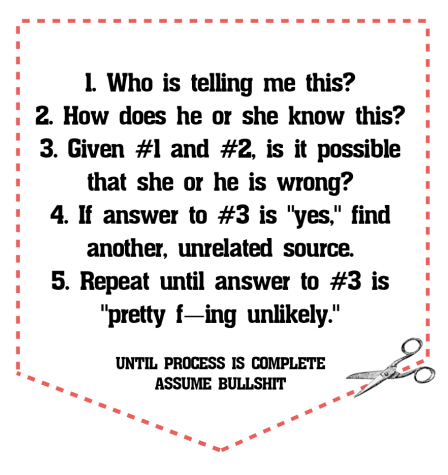Note: I've inserted an asterix into each instance of bullsh*t, so as to render this post safe for work. If you follow the links embedded here, those changes are not made.
If I'm going to read fake news, I prefer to get it from The Onion (website) where I can appreciate the humor. There's a lot of fake news out there purporting to be real, though, and the Bullsh*t Prevention Protocol ("BPP") essentially zeroes in on the old Golden Rule of hoax-detection, which is that "information is only as good as its source." So to spot fake news, one should spend the time to ascertain how credible the source of the news is.
Michelle Nijhuis at The Last Word On Nothing:
Lately, as I’ve watched smarter and better-dressed friends believe all manner of Internet nonsense, I’ve come to appreciate my familiarity with BPP. Especially because we’re all publishers now. (Sharing a piece of news with 900 Facebook friends is not talking. It’s publishing.) And publishing bullsh*t is extremely destructive: It makes it harder for the rest of us to distinguish between bogus news and something real, awful, and urgent.
While BPP is not failsafe, generations of crotchety, underpaid, truth-loving journalists have found that it dramatically reduces one’s chances of publishing bullsh*t.
Via Museum of Hoaxes, where they add:
The problem with the BPP, as Michelle notes, is that it's time-consuming. In fact, it would be impossible to apply the BPP to every news story we read, because in the modern world we're confronted with SO MANY news stories every day. We have to take the majority of them on trust.
So what I would add to her analysis is that we also have to learn when it's worthwhile to take the time to apply the BPP.One strategy is to know that some publications are more trustworthy than others. For instance, the Daily Mail is very low on the trustworthiness index, so we're more likely to have to apply the BPP to its stories.But this strategy is undermined by the fact that other, more trustworthy publications often pick up on stories from less trustworthy publications and report them as news. So it's not always evident what publication is the original source for the news.
The longer-range strategy is to try to develop a built-in BS detector in all areas of your life, not just news - I have to say that one of the things I'm proudest about as a parent is that I raised my kids to question everything, and they're raising their kids the same way. This is actually rather frustrating in practice since even though you realize that things are BS you have to live with them, anyway (why should I wait at red lights if there's no one coming? Why should I comply with laws and regulations that make no sense?), or end up in jail or broke. It's a lot easier for those who never think about it.
Re BS in news stories, Museum of Hoaxes again:
Another, broader strategy is to try to develop a built-in BS detector that will flag questionable stories, telling you which stories to apply the BPP to (regardless of what publication the story appears in). But developing a built-in BS detector is far more art than science. It requires one to be able to sense when something in a story sounds ridiculous or unbelievable, and acquiring this sense for the ridiculous is a skill that's learned over time. It can't easily be reduced to an algorithm.
Michelle suggests another strategy: "you could sit tight for a couple of news cycles and let a professional journalist check into it—we do still have a few of those, after all."

No comments:
Post a Comment